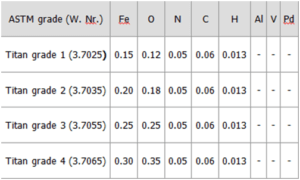Matter
Matter (molecules, atoms) is held together by a certain force, energy. The greater the force that holds the atoms and molecules together, the stronger the matter. Titanium is among the strongest materials on the planet, indicating that the force holding the titanium atoms together must be enormous. When “handling” titanium pyramids, we work with very strong energy …
Mythology
The term “titanium” originates from Greek mythology. Titans were children of the deities Uranus (Sky) and Gaia (Mother Earth). With Uranus ruling the world, Gaia asked the Titans to punish Uranus for holding their siblings within the depths of the Earth. Only one of them, Cronus, dared to fulfil her wish and overthrew Uranus.
The term “titan” is used for those of great spirit, exceptional abilities, men of extraordinary feats or geniuses. The term “titanism” then refers to an individual’s struggle against great powers, a symbol of human effort to be as god-like as possible.
Titanium carries the frequency of creation, activating an energy to start something new, present something to the public. This frequency can be utilised to overcome the fear of failure, make decisions more easily or find the inner strength to become one’s true self.
Alternative
Titanium is exceptional with its strong energy influence and communication abilities. Only a small amount of titanium can emit a very strong energy field into its surroundings. A human being, in its current state of development, can be very sensitive to the field … Thanks to a very special arrangement of atomic and molecular structure, titanium is also capable of receiving, sending and storing data elements – which warrants the term “communication capabilities” without hyperbole.
The Element
Titanium is a grey to silver white, light and hard metal. It excels with its combination of tensile strength and low weight. Compared to iron, which has a density of 7.85 kg/dm3, titanium is only 4.5 kg/dm3. Apart from the low weight, another great advantage is its increased toughness and strength under stress, which is highly utilised, e.g., in the aerospace and space industry. The high resilience and chemical inertness of pure titanium is also utilised in the medicine field, both for surgical instruments and various bone tissue replacement implants.
Despite being one of the most abundant metals in the Earth’s crust, it had been considered a very rare and precious material for a long time. That was because the mining methods commonly used to obtain other metals are ineffective in the case of titanium. First developed in the 1950s in the Soviet Union, the demanding titanium processing technology was kept a secret over a long period of time for strategic reasons. Today, while relatively accessible on the market, titanium is still relatively expensive due to being difficult to process. The purer the titanium, the higher the price.
Pursuant to the ASTM standard, titanium purity tables subdivide commercial titanium by the amount of impurities and optimal applications (space industry, aerospace industry, medical applications).
The titanium used to make our pyramids is chemically pure (see the picture from our attestation).
The values of individual elements are specified in tenths (thousandths) of percent; in order to determine the purity of the titanium, we need to add the values of individual elements and subtract the result from the number 100.


